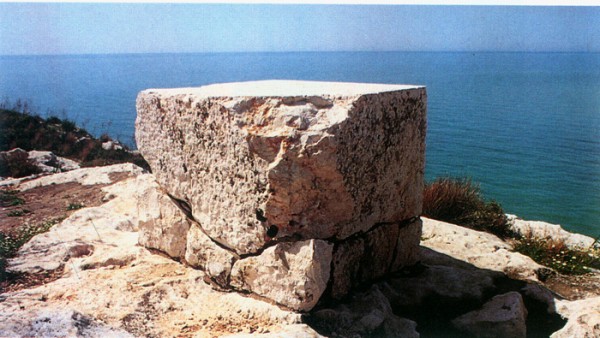The remains of the XIXth and XXth centuries
crowned by the slab of independence
© R. Rihana
Nahr el- Kalb was one of the most difficult barriers to cross on the Lebanese coastline, especially for troops of ancient conquerors of the Middle East. Since the Pharaohs of Egypt, the Assyrians, Chaldeans and Babylonians, Mesopotamia to modern times. The previous issue of our magazine had listed the ancient remains, especially those of:
– Pharaohs of Egypt with Ramses II who developed three inscriptions on the rocks. In one of them he took a prisoner by his hair willing to sacrifice him to the god” Amoun – Raa “.
– Assyrians with Shalmaneser III, Sennacherib and Asarhadon. The latter, and in memory of his victory against Egypt and West Asia, carved a statue showing him standing proudly next to a cuneiform still readable.
– Chaldeans and Babylonians with Nebuchadnezzar II, only king who carved two of his statues on the rocks of Nahr el- Kalb. In one of them we could see him standing in front of the cedars; in the other facing a lion that had assaulted him.
After the Battle of Yarmouk in 636, Arab armies succeeded in occupying the Lebanese coastline and the Beqaa plain, leaving the mountain in the Maronite domination. Lebanese and Syrian shores subsequently experienced a continuous struggle between Arabs and Byzantines that left the rocks of the river forgotten in the annals of history.
In 1515, the famous battle of Merdj Dabeq replaced the Mamluk occupation by the Ottoman Turco on Lebanon, which had failed in a medieval period of despotism to get away the rocks of Nahr el- Kalb from any attention. It is especially towards the end of this domination that the European powers started their interference in the affairs of our region, bringing new modern inscriptions that came to complete the historical pattern of the break ground.
THE RUINS OF MODERN TIMES. Traditions of Nahr el- Kalb continued until modern times, accompanying the great events of the Middle East and telling the story about:
1 The French Expeditionary Corps in 1860-61 which was sent by the Emperor Napoleon III and led by General de Beaufort d’Hautpoul, following a decision by the six powers: France, England, Austria, Russia, Prussia and Turkey. The French General called his troops as follows: “Soldiers, defenders of all great and noble causes, the Emperor decided, on behalf of all civilized Europe, that you would go to Syria to help the troops of Sultan to avenge outraged humanity …
In these famous areas, you will find even the glorious and patriotic memories … “The expeditionary force landed in Lebanon, ended the events, and in memory of his humanitarian work, a slab was placed and described by Ernest Louet, payer of this expedition by these words:
” An inscription will remind our passage to those who come after us.” On one of the rocks at the mouth of Nahr el- Kalb, next to the Phoenician sculptures which Mr.Renan took the footprint, sappers went to burn an imperial eagle with a few words: ” 1860-1861 French expedition in Syria. General de Beaufort d’Hautpoul , commander. Colonel Osmant, Chief of Staff. General Ducrot, commander of the infantry. ”
© R. Rihana
The French expeditionary force of 1860-1861.
2.The victorious entrance of Allied armies in Lebanon and Syria in October 1918 and the occupation of Damascus by the XXIst British army corps; A French regiment of Spahis and Chasseurs d’Afrique; The Arab Army of Sharif Hussein of Hejaz.
© R. Rihana
3.During the same campaign, the occupation of Beirut and Tripoli in October 1918 by the British Army and the ” French Detachment Palestine – Syria.”
© R. Rihana
4. The entry of the “Army of the Levant ” and the French troops in the Levant, commanded by General Gouraud, inDamascus on July 25th, 1920 , following the Battle of Maiçaloun against the Arab Army of King Faisal , son of Sharif Hussein of the Hejaz . This battle was the result of the British policy of compromise and secret international agreements between the allies of 1917 and including two conflicting agreements: the Sykes-Picot agreements who appointed France to play the role of mandatory power in Lebanon and Syria; the letters MacMahon -Hussein who promised to give independence to the “land of the Arabs.”
© R. Rihana
The occupation of Damascus, July 25, 1920, by the French army of the Levant after the battle of Maiçaloun against the Arab army of King Faisal of Syria.
5-The presence of ” The French Army of the Levant ” in Lebanon during the period of the mandate which was celebrated by a yellow stone monument.
© R. Rihana
In memory of the French Army of the Levant.
6-The construction in 1942, of the last stage of the railway line from Turkey to Egypt. A horse statue was placed on top of a slab on which the tourist could read: «Near the spot on 12.21.42, the last spike was driven in the Beirut – Tripoli railway by General Sir Harold Alexander HON , there by Completing the link Between London and Cairo . This section of the line was built by the Australian Building Group falling on the year 1942.”
© R. Rihana
In memory of the last step in the construction of the railway line from Turkey to Egypt.
7. Lebanon’s independence and the evacuation of the country by foreign armies on December 31st, 1946, during the tenure of President Bechara el- Khoury. This slab of Independence was the last, ending foreign occupation of the country. Effectively, and after 1946, the country was governed by its own people.
© R. Rihana
The evacuation from Lebanon by foreign armies on December 31, 1946.













